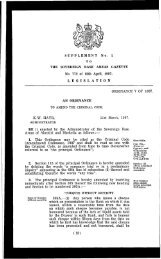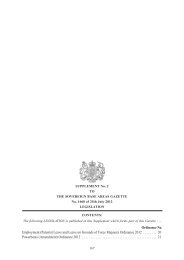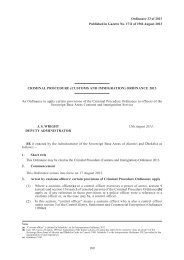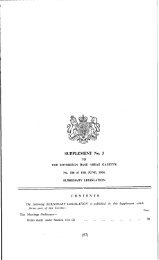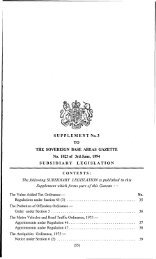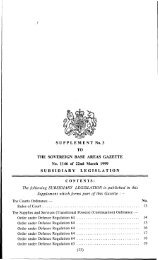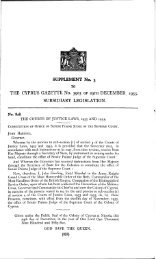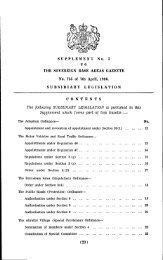Hydrological Study - Sovereign Base Areas Cyprus
Hydrological Study - Sovereign Base Areas Cyprus
Hydrological Study - Sovereign Base Areas Cyprus
Create successful ePaper yourself
Turn your PDF publications into a flip-book with our unique Google optimized e-Paper software.
Consulting CYPRUS<br />
adaptation to the variable temporary habitat (Brendonck 1996). Hatching is generally<br />
spread over several days or even weeks even under favorable environmental<br />
conditions and not all cysts will terminate the diapauses (Hulsmans et al. 2006).<br />
Live specimens (sweep samples with a standard hand net, mesh 1mm) were<br />
collected at all visited localities in the Lake, except where the flamingos were actively<br />
feeding: the birds totally depleted the fairy shrimp populations at the feeding patches.<br />
Only one single specimen of Phallocryptus was captured in dozens of sweeps at the<br />
feeding patches.<br />
Individuals are kept alive in aquaria (Nicosia) in order to produce a cyst bank for<br />
future physiological and taxonomical studies and to record their longevity, at least in<br />
vitro. Additionally, an underwater high definition camera (GoPro) was used to record<br />
abundances and behaviour of P. spinosa at two ponds of the Lake (Fig. 25).<br />
The advantage of such method is the non-destructive evaluation of the populations.<br />
A limitation is the lack of a scale to measure the size of the individuals. However, the<br />
proportion of sexes (Fig. 25B), aggregations (Fig. 25C) and behaviour (Fig. 25D) are<br />
relatively easy to study. Densities can be determined if the observations are made at<br />
a specific place (e.g. camera stationed in one point and records made by time) or<br />
following a pre-determined distance and time.<br />
At one site (#19, Table 2), bottom sediments were collected with a hand held grab<br />
(15x20cm square frame) at the feeding patch of a large group of flamingos. The<br />
sediments were sorted to determine the presence and abundance of P. spinosa cysts.<br />
Only three cysts were found, indicating how efficient is the flamingos’ feeding<br />
mechanisms in removing particles (e.g. cysts, seeds) together with organic matter as<br />
biofilm and also mud.<br />
50



